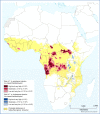Epidemiology of human African trypanosomiasis
- PMID: 25125985
- PMCID: PMC4130665
- DOI: 10.2147/CLEP.S39728
Epidemiology of human African trypanosomiasis
Abstract
Human African trypanosomiasis (HAT), or sleeping sickness, is caused by Trypanosoma brucei gambiense, which is a chronic form of the disease present in western and central Africa, and by Trypanosoma brucei rhodesiense, which is an acute disease located in eastern and southern Africa. The rhodesiense form is a zoonosis, with the occasional infection of humans, but in the gambiense form, the human being is regarded as the main reservoir that plays a key role in the transmission cycle of the disease. The gambiense form currently assumes that 98% of the cases are declared; the Democratic Republic of the Congo is the most affected country, with more than 75% of the gambiense cases declared. The epidemiology of the disease is mediated by the interaction of the parasite (trypanosome) with the vectors (tsetse flies), as well as with the human and animal hosts within a particular environment. Related to these interactions, the disease is confined in spatially limited areas called "foci", which are located in Sub-Saharan Africa, mainly in remote rural areas. The risk of contracting HAT is, therefore, determined by the possibility of contact of a human being with an infected tsetse fly. Epidemics of HAT were described at the beginning of the 20th century; intensive activities have been set up to confront the disease, and it was under control in the 1960s, with fewer than 5,000 cases reported in the whole continent. The disease resurged at the end of the 1990s, but renewed efforts from endemic countries, cooperation agencies, and nongovernmental organizations led by the World Health Organization succeeded to raise awareness and resources, while reinforcing national programs, reversing the trend of the cases reported, and bringing the disease under control again. In this context, sustainable elimination of the gambiense HAT, defined as the interruption of the transmission of the disease, was considered as a feasible target for 2030. Since rhodesiense HAT is a zoonosis, where the animal reservoir plays a key role, the interruption of the disease's transmission is not deemed feasible.
Keywords: HAT; Trypanosoma brucei gambiense; Trypanosoma brucei rhodesiense; human African trypanosomiasis; sleeping sickness.
Figures



References
-
- World Health Organization . Control and Surveillance of Human African Trypanosomiasis Report of a WHO Expert Committee WHO Technical Report Series 984. Geneva, Switzerland: World Health Organization; 2013. - PubMed
-
- Brun R, Blum J, Chappuis F, Burri C. Human African trypanosomiasis. Lancet. 2010;375(9709):148–159. - PubMed
-
- Koerner T, De Raadt P, Maudlin I. The 1901 Uganda sleeping sickness epidemic revisited: a case of mistaken identity? Parasitol Today. 1995;11(8):303–306. - PubMed
-
- Fèvre EM, Coleman PG, Welburn SC, Maudlin I. Reanalyzing the 1900–1920 sleeping sickness epidemic in Uganda. Emerg Infect Dis. 2004;10(4):567–573. - PubMed
Publication types
Grants and funding
LinkOut - more resources
Full Text Sources
Other Literature Sources

